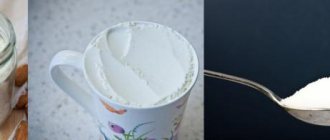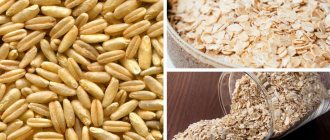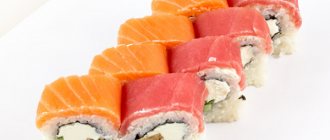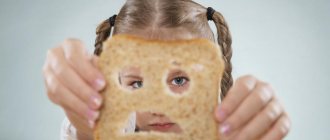How to measure flour
The exact amount of flour is especially important when making baked goods and desserts; there is no way to go wrong here. It is convenient to spoon the flour into a glass and then add it to the dough. You need to know that a tablespoon contains 30 grams of flour. Of course, it takes a long time to add flour to the dough with spoons, and you can make a mistake in counting, so it’s more convenient to pour the flour into a glass first, and then pour the glass into the dough.
The glass you need to use is cut glass. A full glass is 130 g of wheat flour. When you pour flour into a glass, do not compact it, do not shake the glass - this will allow more flour to enter, and, accordingly, the proportion will not be correct. Also note that if you need to sift flour, you should do this after measuring the required amount, because when sifting, the flour increases in volume and becomes airier, which means that in equal volumes, unsifted flour will be heavier than sifted flour. If you make a mistake at this point, you may end up with your dish in a puddle, so don’t forget about it.
How to measure liquid
To measure the exact amount of liquid products without using scales, the same almighty (well, almost) faceted glass will come to our aid. The standard volume of such a glass is 200 ml. To measure the required amount of liquid, you just need to pour it into a glass. It's not difficult, right? True, but do not forget that you need to pour to the very brim.
Liquid can also be measured using spoons; 18 ml of liquid is placed in a tablespoon, and 5 in a teaspoon.
However, the weight that fits into the container also depends on the density of the product. There will be 270 g of jam in a full glass, 50 g in a tablespoon; milk - 200 ml and 20 ml, respectively.
Features of measuring weight with a glass
Also check out these articles
- How to freeze corn for the winter
- Bee packages and their types
- Methods for planting potatoes
- Plum variety Renclod
The measure of a glass may not correspond to the mass of a liquid or bulk product, because these are different definitions. Considering the density of the ingredient, its features, the weight will differ. For example, butter and liquid honey weigh differently due to different densities - this is important to consider! In order for the mass to be always accurate when measuring, it is worth knowing certain subtleties.
- The exact weight of water is obtained only if it is poured to the top of the container.
- Bulk ingredients cannot be compacted by hand; they must be free in the glass. Perhaps when adding flour it is worth checking to see if any voids have formed. To do this, simply stir the flour into the container with a spoon.
- To prevent viscous products from forming voids when measuring them, it is worth putting them on a spoon, and not just pouring them from the main container.
When pouring flour, it is worth checking whether voids have formed
The weight of a product is affected by many indicators, including humidity and density. Below we discuss in detail how many grams are in a faceted glass of various berries, cereals, nuts, liquids, etc.
Important!
A cut glass is always made of durable and thick glass. Such a reliable vessel, even when hitting the floor, does not always crack. This is one of the reasons for its popularity to this day.
How to measure cereals
Cereals are the queen of dishes. It is often added to dough (for example, to bake semolina you need semolina, and for cookies you often need oatmeal), and to vegetables and meat. However, there should not be too much or too little cereal. To measure the exact weight of the required cereal, you can use (guess what...) exactly, a glass! As you understand, there is practically nothing to do in the kitchen without a cut glass without scales.
However, the glass will not contain the same amount of cereal of one type or another. Here is a small list of what and how much will fit in a glass:
- Oat flakes – 80 g
- Wheat flakes – 50 g
- Millet – 200 g
- Buckwheat – 165 g
- Semolina – 160 g
- Pearl barley – 185 g
- Barley groats – 145 g
- Hercules – 50 g
If you don’t need a lot of cereal, you can use a tablespoon. One tablespoon is 25 g of rolled oats, semolina, buckwheat, pearl barley, millet and rice.
Weight of solids in a cut glass
We recommend reading our other articles
- How to plant grapes from cuttings
- Horse breeding
- How to prune gooseberries correctly
- Vladimir cherry
How many grams are in a cut glass of certain solid foods? This question is asked by many housewives. Even knowing how much flour or sour cream is in a glass, it is difficult to determine the weight of beans or walnuts in the same container, because they have a different density and do not fully fill the glass. The table below will make it easier to determine the weight of different solid ingredients.
| Product | Weight to rim (g) | Weight to top (g) |
| Vermicelli | 190 | 230 |
| Peas, peeled | 185 | 230 |
| Beans, peeled | 175 | 220 |
| Dried mushrooms | 80 | 100 |
| Cherry | 130 | 165 |
| Raspberries | 110 | 140 |
| Dried rose hips | 150 | 200 |
| Cranberry | 160 | 200 |
| Dried pears | 55 | 70 |
| Strawberry | 120 | 150 |
| Currant | 140 | 175 |
| Blackberry | 150 | 190 |
| Walnuts | 130 | 165 |
| Pine nuts | 110 | 140 |
| Hazelnut | 130 | 170 |
| Peanut | 140 | 175 |
| Almond | 130 | 160 |
| Seeds | 95 | 125 |
| Raisin | 155 | 190 |
As you can see, the weight of certain products varies significantly. But it is worth remembering that only a clean, dry container is taken to accurately calculate the weight of the components of the dishes!
Important!
With proper use and storage, a cut glass can last for many years. At the same time, it is better not to simply pour hot drinks into it, so as not to crack it. If this is necessary, you should put a teaspoon in the glass. It will take on the temperature of the liquid and the glass will not crack.
How to measure sugar
Sugar is needed almost everywhere, but it is needed only in carefully measured quantities. If you need a lot of sugar, then we have a magical faceted glass at our service - it holds 180 g of granulated sugar.
If you don’t need a lot of sugar, a tablespoon will come to the rescue - 25g of sugar will fit in it
You can even measure lump sugar into glasses! There is no need to crush it for this - 140 g of lump sugar fits in a glass.
Lifehacks
Flour can be measured in any container, just know the volume of the container, and then we will tell you: 100 ml contains approximately 64 grams of flour, 150 - 96 g, 180 - 115 g, and 300 ml - 190 grams of flour. Then it's a matter of simple mathematics and a calculator.
Tip: when measuring products for cooking, if the order is not important, start with dry products: flour, cereals, sugar. If a certain amount of product remains on the walls of the container, later, when adding liquid ingredients, you will mix this amount into the dough - this way nothing will be wasted.
Enjoy cooking even without a scale! We hope this article will help you understand weights and measures, and there will be no more liquid pies due to a small amount of flour, or over-sweetened dishes.
LiveInternetLiveInternet
Quote from Lyubava_ya's message
Read in full In your quotation book or community!
Weight and volume tables
see also here and here Universal table of volumes 1 glass - 240 ml. 3/4 cup - 180 ml. 2/3 cup - 160 ml. 1/2 cup - 120 ml. 1/3 cup - 80 ml. 1/4 cup - 60 ml. 1 tbsp. 15 ml. 1 tsp - 5 ml. 1 tbsp - 3 tsp 1 cup-16 tbsp. 1 liter-4 glasses +2 tbsp. Weight/volume ratio of various products. Oil. 1 glass of vegetable oil-200 gr. 1 glass of butter -240 gr. 1 tsp l oil-15 gr. Crumbs 1 cup of cake crumbs-110 gr. 1 cup dry bread crumbs-125 gr. Dried fruits 1 cup of dried fruits - chopped - 150 gr. Flour, cocoa, starch. 1 glass of flour -140 gr. 1 tbsp. -10 gr. 1 tsp 3 gr.
Sugar is white. 1 glass -200 gr. 1 tbsp. 12 gr. 1 tbsp - 15 gr. 1 tsp 4 gr. 1 tsp - 5 gr. Powdered sugar. 1 glass - 120 gr. 1 tbsp. 8 gr. 1 tsp approximately 3 gr. Honey, corn syrup. 1 glass-320 gr. 1 tbsp - 20 gr. 1 tsp 7 gr. Jam 1 glass-330 gr. Eggs. Large egg No. 1 - 65 gr. and more Medium egg No. 2 - 60 gr. small egg No. 3-50 gr. Ratio of fresh to dry yeast. 50 gr. fresh yeast-17 gr. (2 tablespoons without top) dry yeast. Miscellaneous 1 cup almonds/nuts crushed into flour - 85 gr. 1 cup of nuts/almonds, crushed into crumbs - 100 g. 1 tbsp. nuts/almonds - crumbs - 6 gr. 1 cup coconut flakes-00 gr. 1 glass of chocolate chips-200 gr. 1 glass of oatmeal - 100 gr. 1 cup extra long rice -200 gr. 1 cup round rice -210 gr. 1 tbsp. dry yeast-10 gr. 1 glass of salt 200 gr. 1 tbsp. salt-20 gr. Gelatin. 1 package-14 g. 1 tbsp. - 10 gr. 1 sheet of gelatin-4 gr. 14 gr. gelatin - 3 1/2 sheets.
One plate of sheet gelatin is usually equal to 2 grams of granulated gelatin. Baking powder, soda. 1 package -10 g - approx. 1 tbsp. 1 tbsp - 9 gr. 1 tbsp. without top 8-9 gr. 1 tsp -3 gr. For 1 kg of flour, 2 teaspoons of soda or 4-6 tsp are consumed. baking powder. Saffron is the most expensive spice in the world. The smallest amount of saffron gives products a golden yellow color and a wonderful, unique taste. Conversion table as a percentage of the required number of products when changing the diameter of the mold. Increase from diameter 22 cm - 24 cm -20% 22 cm -26 cm -40% 22 cm -28 cm -60% Decrease from diameter 26 cm -24 cm -15% 26 cm -22 cm -30% 28 cm -22 cm -40%
CONVERTING THE WEIGHT OF PRODUCTS TO OTHER VOLUME MEASURES PRODUCTS GRAMS
GRAMS | |||
PRODUCTS | CUP250 ML | DINING ROOMSPOON | TEA ROOMSPOON |
| Peas | 230 | 25 | 10 |
| Groats "Hercules" | 90 | 12 | 6 |
| Buckwheat | 210 | 15 | 7 |
| Semolina | 200 | 30 | 10 |
| Pearl barley | 230 | 25 | 8 |
| Barley groats | 180 | 20 | 7 |
| Corn flour | 160 | 30 | 10 |
| Starch | 200 | 30 | 10 |
| Wheat flour | 160 | 25 | 10 |
| Sweet peas | — | — | 4,5 |
| Black peppercorns | — | — | 5 |
| Ground red pepper | — | — | 1 |
| Oatmeal | 190 | 20 | — |
| Lentils | 210 | — | — |
| Beans | 220 | 30 | 10 |
| Cornflakes | 50 | 7 | 2 |
| Millet | 220 | 25 | 8 |
| Rice | 230 | 25 | 9 |
| Pasta | 230 | 15 | 5 |
| Powdered sugar | 190 | 25 | 8 |
| Granulated sugar | 200 | 30 | 12 |
| Salt | 325 | 30 | 10 |
| Breadcrumbs | 125 | 15 | 5 |
| Ground cloves | — | — | 3 |
| Unground cloves | — | — | 4 |
| Mustard | — | — | 4 |
| Cocoa | — | — | 4 |
| Drinking soda | — | 25 | 12 |
| Ground cinnamon | — | 20 | 8 |
| Ground coffee | — | 20 | 7 |
| Lemon acid | — | — | 3 |
| Honey | 325 | 35 | 12 |
| crushed nuts | 120 | 20 | 7 |
| Hazelnuts (kernels) | 160 | 30 | 10 |
| Peanuts (kernels) | 170 | 25 | 10 |
| Almonds (kernels) | 160 | 30 | 10 |
| Berry puree | 350 | 50 | 20 |
DAIRY | PRODUCTS | FATS | |
| Margarine | 240 | 20 | 5 |
| Ghee | 245 | 20 | 5 |
| Butter | 210 | 40 | 15 |
| Condensed milk | — | 30 | 12 |
| Whole milk | 250 | 20 | 5 |
| Sour cream (15%) | 250 | 25 | 10 |
| Fat cottage cheese | — | 17 | 5 |
| Vegetable oil | 240 | 20 | 5 |
| Mayonnaise | — | 15 | 4 |
FRUITS | BERRIES | ||
| Cranberry | 145 | — | — |
| Gooseberry | 210 | — | — |
| Raspberries | 180 | — | — |
| Cherry | 200 | 30 | — |
| Red Ribes | 175 | — | — |
| Black currant | 155 | — | — |
| Fresh blueberries | 200 | — | — |
| Dried blueberries | 130 | 15 | — |
| Dry rosehip | — | 20 | — |
| Cowberry | 140 | 20 | 6 |
| Blueberry | 260 | — | 6 |
| Blackberry | 190 | — | — |
| Jam | 330 | 40 | — |
| Raisin | 165 | 25 | 15 |
AVERAGE WEIGHT OF INDIVIDUAL PRODUCTS
PRODUCTS (1 pc.) | GRAMS |
| Potato | 100-120 |
| Bulb onions | 75-100 |
| Carrot | 75-100 |
| Cucumber | 100-120 |
| Parsley (root) | 50-70 |
| Head of cabbage | 1500-1700 |
| Celery (root) | 100-120 |
| Tomato | 100-120 |
| Beet | 150-170 |
| Apple | 100-120 |
| Pear | 100-150 |
| Cauliflower | 800-1000 |
| Lemon | 100 |
| Egg | 55-65 |
| The successful preparation of most dishes depends on the exact adherence to the proportions of products indicated in the recipe. Most often, the weight of products is indicated in grams. But how to determine it at home? Our table of weights and measures will come to the rescue. How many grams of flour are in one thin glass? What about faceted? How much does a teaspoon of mustard or a tablespoon of honey weigh? What is the weight of an average onion or potato? You can find out all this without having to worry about using scales, but simply look at the table of measures and weights of products. Before determining the weight of products, you should familiarize yourself with certain rules. If you do not follow them, you will not be able to accurately measure the amount of food you need.
The capacity of the dishes for measuring the weight of food is as follows:
Liquid and viscous productsProducts
Cereals and flakes
Bulk products
| |||||||||||||||||||||||||||||||||||||||||||||||||||||||||||||||||||||||||||||||||||||||||||||||||||||||||||||||||||||||||||||||||||||||||||||||||||||||||||||||||||||||||||||||||||||||||||||||||||||||||||||||||||||||||||||||||||||||||||||||||||||||||||||||||||||||||||||||||||










